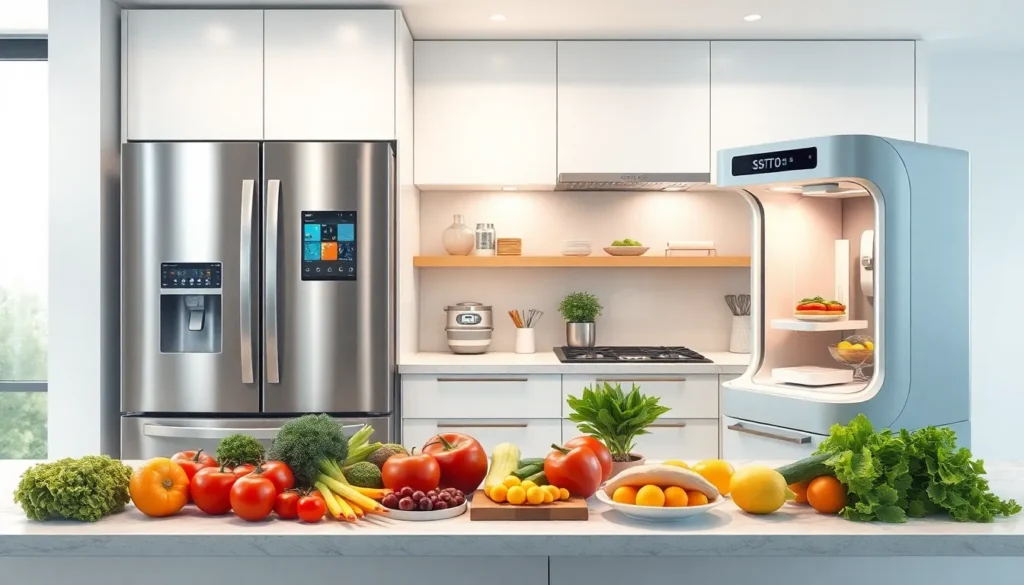In a world where avocado toast reigns supreme and plant-based burgers are the new norm, food tech innovations are shaking things up in the culinary landscape. Gone are the days of simply cooking; now, it’s all about smart kitchens and lab-grown delights that promise to tickle taste buds while saving the planet. Who knew that technology could be the secret ingredient to a better meal?
Imagine a future where your fridge knows exactly when you’re out of eggs and orders them for you, or where 3D printers whip up gourmet dishes at the touch of a button. Food tech isn’t just a trend; it’s a revolution that’s transforming how we eat, cook, and think about food. Buckle up as we dive into the deliciously innovative world of food tech, where every bite is a step toward a tastier, smarter future.
Table of Contents
ToggleOverview of Food Tech Innovations
Food tech innovations reshape how society interacts with cuisine. Smart kitchens streamline meal preparation with cutting-edge gadgets. For instance, appliances like smart ovens adjust cooking times based on recipes, ensuring consistent results. Automation enhances efficiency, allowing individuals to focus on creativity rather than tedious tasks.
Lab-grown food represents another groundbreaking development, significantly impacting sustainability. Companies grow meat substitutes made from plant-based ingredients, reducing the carbon footprint associated with traditional livestock farming. Additionally, advancements in cellular agriculture promote food security by offering healthier, ethical alternatives.
3D food printing offers a unique approach to meal presentation and customization. This technology creates intricate designs from a range of ingredients while minimizing waste. Chefs can print personalized dishes tailored to dietary preferences or restrictions.
Data-driven insights from food tech shape culinary choices, making meal planning smarter. Apps analyze user preferences and nutritional needs, suggesting recipes that align with personal health goals. Meal delivery services use algorithms to deliver fresh ingredients tailored to specific diets, enhancing convenience.
Food traceability innovations improve transparency in supply chains. Technologies such as blockchain allow consumers to track the origin of ingredients. This fosters trust and empowers informed choices regarding food sources.
These advancements prove that food tech is integral to reshaping the culinary landscape. Innovations not only make food preparation more efficient but also promote sustainability and enhance consumer experiences. Each breakthrough signifies a monumental shift in the relationship between technology and food.
Key Technologies Shaping the Industry

Food tech innovations significantly enhance how individuals interact with their culinary practices. Notable technologies include artificial intelligence and blockchain, both of which contribute to efficiency and transparency within the industry.
Artificial Intelligence in Food Production
Artificial intelligence plays a crucial role in streamlining food production processes. Machine learning algorithms analyze data from various sources to predict demand accurately. This leads to optimized inventory management, reducing waste significantly. Automated systems monitor crop health, allowing farmers to address issues promptly. Robotics also enhance precision in harvesting, ensuring minimal damage to produce. Personalized nutritional insights derived from AI help consumers make informed choices that align with their health goals. Overall, AI enhances sustainability while improving productivity across the food supply chain.
Blockchain for Food Transparency
Blockchain technology fosters transparency in food supply chains. By creating immutable records, it allows stakeholders to trace food products from farm to table. This transparency builds consumer trust, as buyers can verify the origin and conditions under which their food was produced. Efficient data sharing among suppliers, distributors, and retailers reduces fraud risks and enhances food safety. Additionally, blockchain can streamline recalls by pinpointing contamination sources quickly. Employing smart contracts further automates transactions, increasing efficiency and accuracy in the supply chain. Ultimately, blockchain technology is revolutionizing how consumers engage with food, ensuring accountability at every level.
Sustainable Practices in Food Tech
Sustainable practices in food tech play a crucial role in addressing environmental challenges. Innovations like vertical farming and lab-grown meat are leading the way.
Vertical Farming Innovations
Vertical farming represents a shift in agricultural methods, enabling food production in urban areas. These farms utilize stacked layers to grow crops, optimizing space and reducing land use. Hydroponics and aeroponics support growth without soil, which conserves water and minimizes pesticide usage. Data suggests vertical farms can produce up to 10 times more crops per square foot compared to traditional methods. Energy-efficient LED lighting accelerates growth cycles, further enhancing productivity. This model reduces transportation emissions by allowing food to be grown close to consumers. Additionally, vertical farming lowers the risk of crop failures due to environmental factors, ensuring a stable food supply.
Lab-Grown Meat Advancements
Lab-grown meat technologies focus on producing meat without the environmental impact of traditional animal farming. These advancements require significantly less land, water, and energy. Lab-grown methods can cut greenhouse gas emissions by up to 96% compared to conventional beef production. Using animal cells, scientists cultivate muscle tissue in controlled environments, creating healthier meat alternatives. These products eliminate the need for antibiotics and hormones, addressing food safety concerns. Consumers increasingly demand sustainable protein sources, making lab-grown meat a viable solution. Innovations in this field aim to enhance taste and texture, ensuring acceptance among meat lovers. This technology’s scalability offers potential for global food systems, promising a future of sustainable eating.
Enhancing Consumer Experience
Food tech innovations significantly enhance the consumer experience by integrating technology into daily cooking and nutrition practices.
Smart Kitchen Appliances
Smart kitchen appliances streamline meal preparation. Devices like smart ovens adjust cooking methods for optimal results, allowing users to focus on creativity rather than precision. Intelligent fridges monitor inventory, automatically reordering staples when supplies run low. Users benefit from time savings and convenience, ensuring meals are both nutritious and delicious. Sensors embedded in appliances also monitor food freshness, reducing waste and promoting sustainability. Smart kitchen innovations cater to the needs of busy lifestyles, making home cooking simpler and more enjoyable for everyone.
Personalized Nutrition Solutions
Personalized nutrition solutions empower consumers to make informed dietary choices. Apps analyze individual preferences and goals, offering tailored recipe suggestions and meal plans. AI-driven insights deliver dietary recommendations based on health data, aligning with user needs. Meal delivery services utilize algorithms to curate fresh ingredients that match nutritional requirements, making healthy eating accessible. This approach fosters a deeper connection with food, promoting mindful consumption and well-being. As consumer interest in nutrition grows, these innovations provide essential support for healthier lifestyle choices.
Future Trends in Food Tech
Food tech continues evolving, driven by innovations that enhance sustainability and consumer experience. Smart kitchens will incorporate more seamless integration of AI to predict cooking needs and automate processes. Plant-based meat alternatives are gaining traction, with advancements focused on improving taste and texture.
3D food printing technology is becoming more prevalent, allowing chefs to create intricate dishes while minimizing waste. Transparency through blockchain technology is essential, as consumers demand to know the origins of their food. Enhanced food traceability will foster trust, leading to informed purchasing decisions.
Personalized nutrition is on the rise, with apps using AI to tailor meal plans based on dietary preferences and health goals. Urban vertical farming is increasing food accessibility, producing crops locally while conserving resources. Lab-grown meat is advancing, significantly reducing greenhouse gas emissions compared to traditional farming methods.
Consumer awareness around environmental impacts is pushing demand for innovative protein sources, prompting companies to focus on sustainable practices. New cooking appliances will emphasize ease of use, encouraging consumers to explore culinary creativity. Increased emphasis on health and wellness will drive the development of nutritionally balanced food technologies.
These trends indicate a pivotal shift in the culinary landscape, highlighting the intertwined relationship between technology and food. Each advancement contributes to a more sustainable and enjoyable experience for consumers.
Food tech innovations are reshaping how people interact with their meals. As technology continues to evolve, it opens doors to new culinary experiences and sustainable practices. The integration of smart kitchens and lab-grown foods not only enhances convenience but also promotes a healthier planet.
With advancements in AI and blockchain, the food industry is becoming more efficient and transparent. Consumers are empowered to make informed choices, leading to a deeper connection with their food.
Looking forward, the ongoing evolution in food tech promises to further enhance sustainability and creativity in the kitchen. This transformative movement is more than just a trend; it’s a fundamental shift that will define the future of food.




